[iPhone]
 The Most Powerful Tequila App Ever Created for the iPhone: Tequila Matchmaker
The Most Powerful Tequila App Ever Created for the iPhone: Tequila Matchmaker
[/iPhone]
[android]
 The Most Powerful Tequila App Ever Created for Android: Tequila Matchmaker
The Most Powerful Tequila App Ever Created for Android: Tequila Matchmaker
[/android]
Extra Añejos — the most aged and expensive form of tequila — attracts all palates, from seasoned tequila drinkers to newbies who find their rich oak flavors reminiscent of other dark spirits.
This is still a relatively new category for tequila. The CRT officially established “Extra Añejo” (XA) as a fourth classification in 2006, for tequilas aged 3-years or longer. Fans of XAs often say they enjoy “the complexity and depth that an oak barrel can bring.”
But other than the oak, what are extra añejo drinkers looking for? Do they still want the presence of agave, or are they hoping that extra time in the barrel will bring more complexity? Or, is it something else entirely? We conducted a blind taste test with 29 members of the Tequila Matchmaker Tasting Panel to find out.
This blind taste test consisted of:
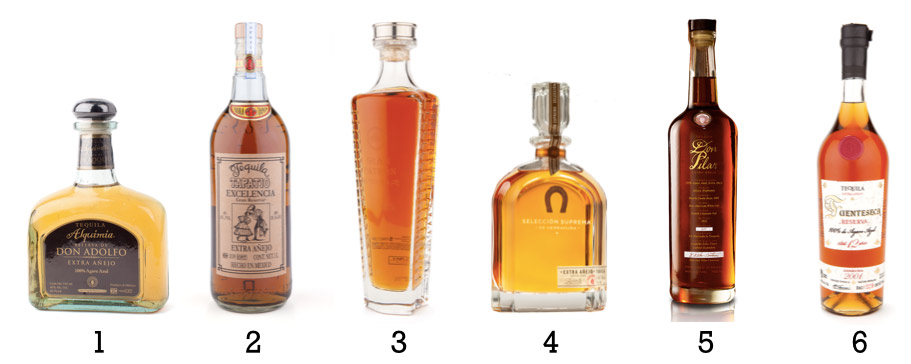
-
1) Alquimia Extra Añejo ($100)
2) Tapatio Excelencia ($160)
3) Gran Patron Piedra ($300)
4) Herradura Seleccion Suprema ($300)
5) Don Pilar Extra Añejo ($140)
6) Fuenteseca 12-year Extra Añejo ($290)
(Prices for these products as of May 2015, from ZeeTequila.com.)
First off, we selected this particular lineup of extra añejo tequilas because they are of the highest quality, are well respected, represent a range of flavors and price points, and are worthy of attention.
THE RESULTS
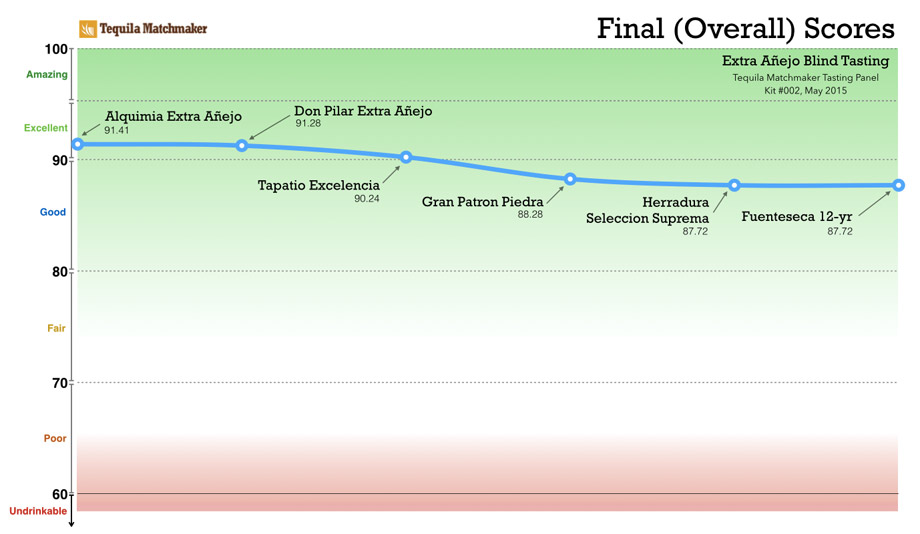
What surprised us the most was that the combined aroma, flavor, and finish scores were all relatively close to each other, and what seemed to matter the most was price, or value.
For instance, the top 2 rated tequilas, Alquimia Extra Añejo and Don Pilar Extra Añejo, were the most affordable at $100 and $140. But, these same tequilas were found to have dramatic differences. Panelists said that Alquimia had the most agave (and the least oak) of the samples, while Don Pilar had the most oak (and second least agave.) All six of the samples contained at least some agave, according to our panelists.
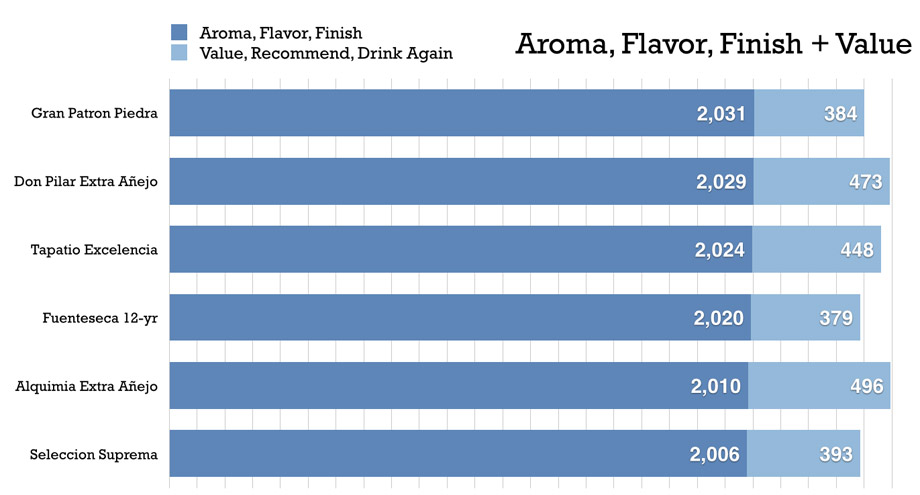
Only 31% of the panelists consistently rated the samples with the most agave highest. The ratings of the other 69% indicate that agave wasn’t a requirement for their enjoyment.
When value was taken out of the equation, the sample that scored highest (and had the least agave, according to our panelists) was Gran Patron Piedra, a 100% tahona-crushed product made by Patron. But the $300 price tag dragged down its value score, making it land in 4th place overall.
The price tolerance was also something we tracked. There was a noticeable drop-off in value scores near $200, suggesting that there may be a psychological barrier at this price point.
To make sure that price wasn’t the only factor at play we also looked at complexity. What we found was:
-
– Complexity actually decreased as oak increased
– Complexity increased as agave increased
– The less oak, the more other aromas and flavors (including agave) were detected
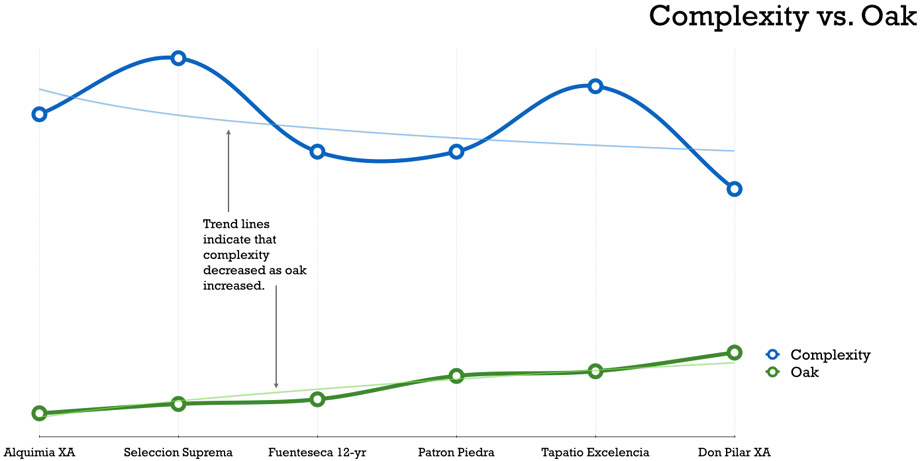
So, what can we concluded from this? Value and the presence of oak matters the most. And, since we also found that complexity decreased as oak increased, complexity is not something that extra añejo drinkers are necessarily looking for, despite these common claims.
Tequila is an amazingly complex distillate, thanks to the magic of the agave plant. But when oak is introduced, the agave can become a subtle accent instead of the main player. With this in mind, you may ask, why do extra añejos even exist? What purpose do they serve?
Since agave and complexity are not essential for most people in the extra añejo category, the strong presence of oak serves to introduce non-tequila drinkers (hello bourbon!) to the tequila category.
Our own tequila experience started with aged products. Añejos and extra añejos dominated our home bar, and we rarely drank blancos. As time wore on, and our experience with tequila increased, we naturally migrated to lesser-aged and more complex products. Today we spend most of our time with blancos and lightly aged reposados.
For us, extra añejos were a friendly (but expensive) onramp to this tequila highway we’re (still) traveling on. The beautiful thing about this ride is that there’s a destination for every palate.
Which extra añejo tequilas do you enjoy, and why? We’d love to hear from you in the comments area below!


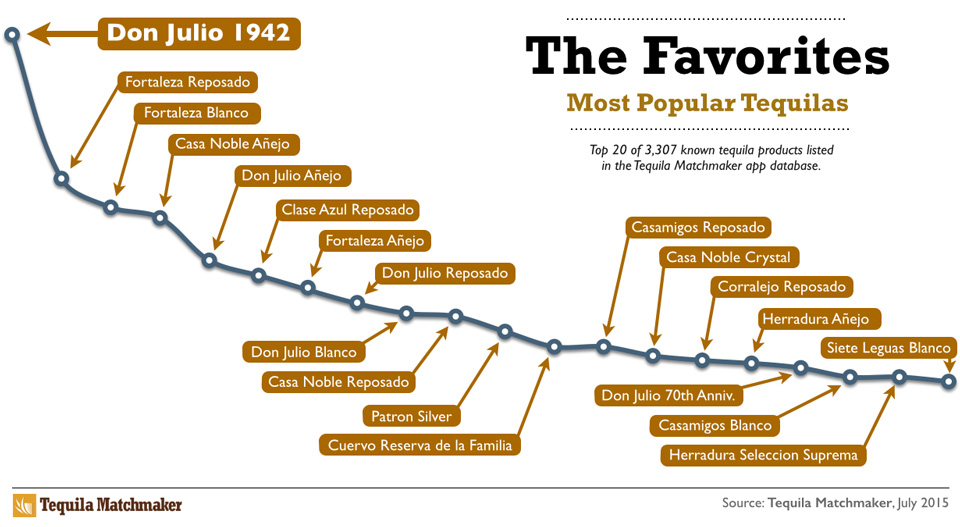
Wow! I am shocked to find out my feelings towards tequila mirrors yours exactly. I no longer drink Anejos and Extra Anejos. Blancos, such Siete Leguas, and Reposados, such Tres Generaciones, are my drink of choice now. My Herradura Extra Anejo bottle sits very pretty, and unopened, in my bar. I’ll probably never open it!
Ditto to the above post, initially the allure of XA drew me in, but as I gained tasting experience I much prefer blanco’s. Which ones? I’m glad you asked…Fortaleza, Tapatio, Siete Leguas & occasionally what ever you happen to be pouring!
I have always had a preference for anejos but I have also always been happy drinking any tequila that is halfway decent. Current blanco favorite is Casa Amigos. Current (and probably for the foreseeable future) favorite reposado is Clase Azul (although it’s more like an anejo than a reposado). I also find Fortaleza reposado decent although I’d rather spend the money on something else usually. Casa Amigos anejo is nice too. Of course since the Casa Amigos tequilas are made by the Clase Azul producers, it’s probably because I like their other stuff so much. I haven’t had all of the extra anejos listed here but of all the ones that I have had, the Don Pilar definitely stood out as one of the best.
2 of my faves right at the top. I don’t often drink XA but when I do, Don Pilar and Alquimia join my Crotalo 7-year and my ET70 in the favorites aisle.
I was explaining this exact same thing to a friend of mine who really isn’t a tequila fan. It seems the more expensive and longer barrel aged tequilas are approaching scotch whiskey or bourbon. If I want all that woodiness I prefer a good single malt. And what is interesting is that good single malt scotch is cheaper and potential better when you factor in the cost. A 5yr tequila might cost $150 whereas a 25 year old single malt is the same price. A good 10yr old single malt is about $50. I don’t see the market value of these expensive tequilas other than to impress your friends on how much you spent. Price to value is way off for most consumers. I can’t say I like Blancos over anejos but I do enjoy a smooth complex tequila at a reasonable price. Thanks for this article. I thought I was alone on this one as well
I really do enjoy the Anejos and Extra Anejos, but that being said, I still enjoy the blancos and reposados. My absolute favorite of all time is the Asom Broso 11 year. I have one bottle that I received as a gift and I’ve never had anything like it – as much as I like it, I won’t be buying myself another bottle at the price! One of my favorite go-to tequilas is the Clase Azul reposado. Would love to try their anejo, but again, at that price, I don’t see myself buying a bottle.
I have had the Fuenteseca 18 yr, and while it is very good, I expected a little more from it.
You hit my 2 favorites right on the head!
For Blancos, I like Herradura, Espolon, and Fortaleza. I have tried only 2 extra anejos and the price as well as the taste had big difference. Siembra Azul extra anejo (sura) about $110 and Partida extra anejo about $350. The Partida was way better than the Siembra Azul but a little to pricey for me..
I disagree. First I have to say I enjoy the reposados most. Classe azul is probably my favorite reposados although quite complex in my view but still better than the Classe Azul XA. Black which is overpriced There are also very good agave liquors like Los Ozunas. Quite a few blancos are good but I find the burn sometimes takes away too much from the flavor. Reposados to me offer the best balance of agave and flavor that is tequila. When you get to the XA, you really have to change and move away from the purist tequila mindset. They are a more refined flavor pallet that tempers the agave and strengthens the other flavors, not just the wood tannins but vanilla, butterscotch, cinnamon or whatever else is on there. Tequila aged extra yields more of a brandy, bourbon, scotch and cognac type liquor with flavors very distinct and unique to tequila. Yes the prices are high but you can’t get the same flavor ranges out of the other liquors. A 5 yr tequila can be much more complex and smooth than a 15 yr scotch. Just my humble opinion
My Extra Anejo of choice is Jose Cuervo Reserva De La Familia. I used to prefer Don Julio 1942 but they are the same price basically (give or take $10-20) and in my opinion the De La Familia is darker (just prefer it) smell is incredible (best smelling spirit I’ve came across), and taste is “delicious.”
I’m into añejos and reposados and would like to taste extra añejos, the smoothest the tequila tastes, the better for me. I do believe aging is for gaining complexity of flavors beyond agave itself , it’s valid to prefer blancos or reposados rather than others.
Definitely comparing XA against whisky is the first mistake we can made with tequila (the second could be choosing “highlanders” tequilas just because sound fancy).
We have the unique and extraordinary privilege to do tequila with such exclusive plant and its terroir, let’s give tequila a chance to age not for keeping up with another spirits but find extraordinary flavors at it’s age pinnacle.
My research shows reposado to be the most popular Tequila iteration in Mexico. I wasn’t too surprised when I learned that because a bit of oak aging does indeed tend to mellow the burn, while imparting a host of additional flavour notes even a wool-dyed Blanco fan can appreciate. I find my mood is the primary driving motivation for my Tequila type at any given time. I’ve also found many producers seem to have a hard time getting it right within a classification. But, in general I prefer an aged agave for sipping. Fortaleza Rep is a fave along with El Jimador Rep for affordable day-to-day. I will say however, my friends never turn down my privately aged Extra Añejo. Just seems to disappear fairly quickly.